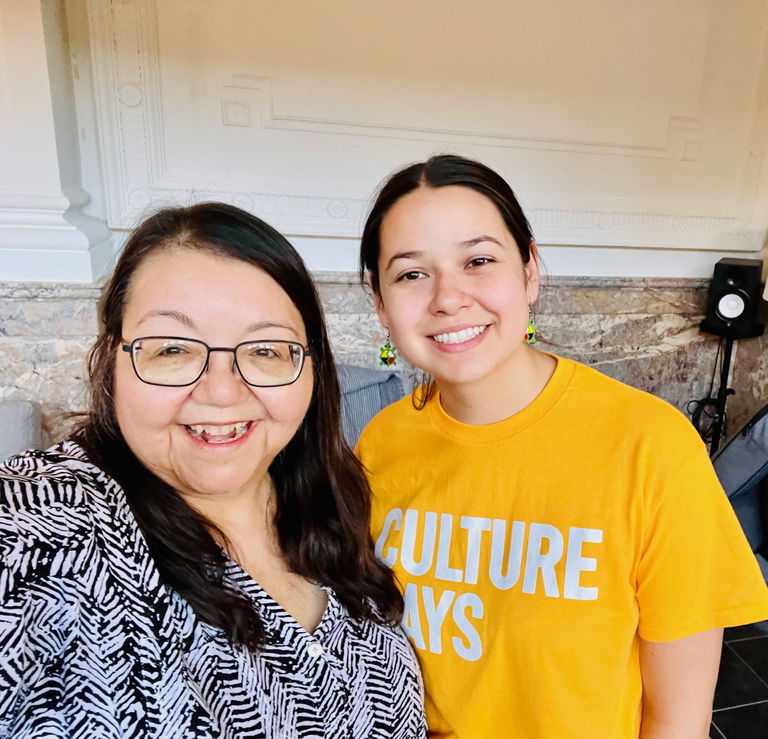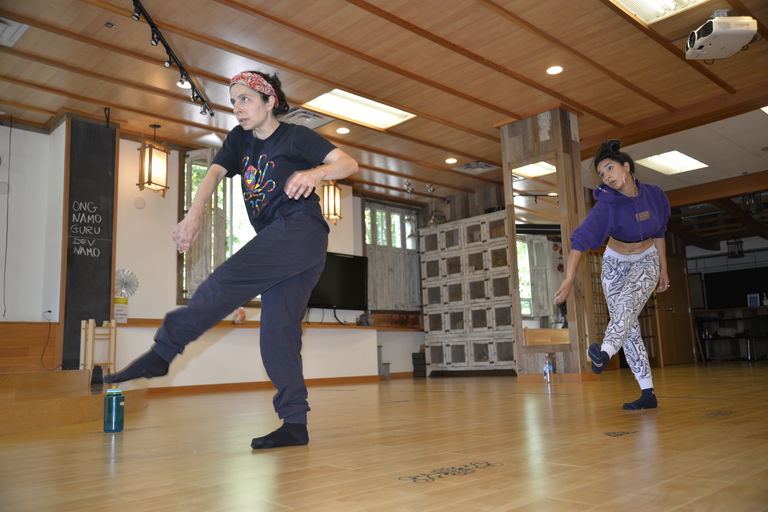
Decolonizing Capitalism: An Interview with Edward Fu-Chen Juan and Damian John
Mallory Gemmel
Aug 17, 2021

Edward Fu-Chen Juan and Damian John are both ambassador alumni from 2020 BC Culture Days. The artists connected last year through the ambassador program and have been finding ways to work together since. With support from the Nelson and District Arts Council, the pair recently completed a one week long residency at The Narrows Art Retreat on Kootenay Lake.
John is a Tl’azt’en drawer, painter, and self-described artisan poet. He is an indigenous advocate who uses art and storytelling to explore his heritage. Since before Culture Days, John has been formulating projects that focus on the idea of decolonization. Juan, who was born in Taiwan, has lived and worked as a commercial printmaker by trade in Vancouver for several years. As part of his daily practice, Juan makes his own paper and ink materials from foraged ingredients which he sources from plants indigineous to B.C.
Through processes of teaching and learning, John and Juan have collaborated to create a project they call Decolonizing Capitalism. Throughout their collaboration, the two artists have mentored one another, shared personal experiences and contemplated their personal cultural nuances. During their residency, the artists sourced cedar, saskatoon berries, and more to weave paper and create natural inks. Using locally foraged plant materials, Juan and John make printed interpretations of paper money. The artists’ money prints reflect the effects of capitalism and colonialism in Canada. In creating new visuals for money, the artists break down and reinterpret money as a symbol for currency and value. Through Decolonizing Capitalism, the artists inquire about the notion of value—they question how the concept of value morphes and transforms across different cultures, spiritualities, and identities. They ask, what is valuable? And, how do we determine what is valuable to us?
BC Culture Days interviewed the artists about their collective residency, their Decolonizing Capitalism project, and their time as BC Culture Days Ambassadors.
Mallory: Can you tell us about yourselves as individuals? How do each of you describe your current artistic practices?
Damian: My given name is Damian John. I’ve lived and worked in the Kootenay area, the traditional territory of the Sinixt, the Okanagan, and Ktunaxa for 11-ish years now. I stepped into being a full-time artist, probably four or five years ago, in various capacities. My practice entails all kinds of things.
Basically, I explore the creative aspects of the brain and my thought patterns. I do paintings. I do digital work. I do some sculptural things. I work with rock and wood. I’ve worked with glass. I just learned papermaking and indigenous plant dyeing from Ed, which was super cool.
I’m always adding to my skill sets. I’ve really wanted to learn about the printmaking and the papermaking that Ed has been doing. It melds well with some of the stuff that I’ve been thinking about.
Ed: I usually work with natural ingredients. I’m trying to find a connection right now between contemporary art practices, values, and issues with traditional techniques. Presently, I use paper as a reinforcement of my practice. It’s traditionally valued where I’m originally from in Taiwan. That’s where I was born and raised. My family immigrated to Canada when I was a child.
I live in Vancouver, which is on the traditional lands of the Sḵwx̱wú7mesh (Squamish), Stó:lō and Səl̓ílwətaʔ/Selilwitulh (Tsleil-Waututh) and xʷməθkʷəy̓əm (Musqueam) Nations.
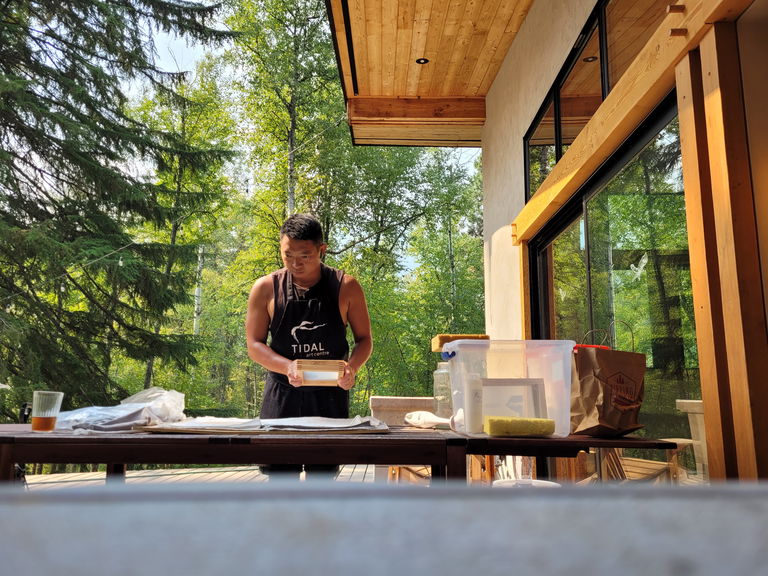
Mallory: You are both BC Culture Days Ambassador alumni! Did you two connect during last year’s Culture Days? What drew you to one another’s practices?
Damian: A lot of my work considers indigenous advocacy. I’ve been using art to put voice to some of my own stories. I’m working on a creative project that is playing with the idea of what is valuable in relation to money.
Money and myself, we’ve always had this cranky relationship because of the imagery that we put on our paper currency. There’s John A. Macdonald, Wilfrid Laurier, and the Queen. All of these people are very white and empire-based, colonial, and racist individuals who are celebrated on Canadian money and have been for my lifetime. Recently, they’ve started to put different imagery onto money, but most of us have grown up in a world where there are these images on this thing (money) that we hold in high value. Not very many people that I circle around are questioning or thinking about these things. I wanted to explore this idea creatively, so I started working on this project from a design perspective. Ed was specifically exploring papermaking and indigenous plant inks already. Before I talked with him, I was thinking about what paper money would look like if there were different thought processes put into the idea of creating it. For example, the images and what it’s made out of. Sonny Assu, my mentor from BC Culture Days, suggested I make money on cedar paper. Because Ed was working on creating paper out of indigenous plant matter, I asked him if he would make me some paper. So, he made me some cedar paper, which I still have a bunch of. I’m going to do some printmaking on it.

Ed, correct me if I’m wrong, I think that got things percolating a little bit for you to some degree? I think I also asked if we could work together. Then Ed started to brainstorm how we could collaborate, how we could work together, and where we could do that. He found the Narrows Art Retreat and applied for it. It’s a local residency, so I had to be a part of it in order for us to both be a part of it.
Ed: I reached out to the Nelson & District Arts Council and found out that they had residency programming in the past. Because of the COVID 19 pandemic, I wasn’t sure if it was still going to happen.
Damian was on board. I actually bugged the arts council quite a bit. I emailed them maybe once a month for a couple months to ask “Hey, are you guys still doing this?” With the pandemic, you just never know the state of arts funding and if there are opportunities to travel.
We applied in January, and we found out we got the jury’s blessing. We were accepted, I think, in March or April. Damian and I talked about what we wanted to accomplish with the residency. Because it’s only one week long, I requested a second week. I’m currently here for the second week just to continue to work on what I already started with Damian.
Mallory: I know that your collaborative residency at The Narrows Art Retreat has just come to an end. How was your time during the residency, and what did you two specifically work on?
Ed: We started with foraging the local flowers, plants, and cedar blocks. Damian and I actually got cedar and the hemlock chips from Damian’s neighbour. They run a small lumber yard.
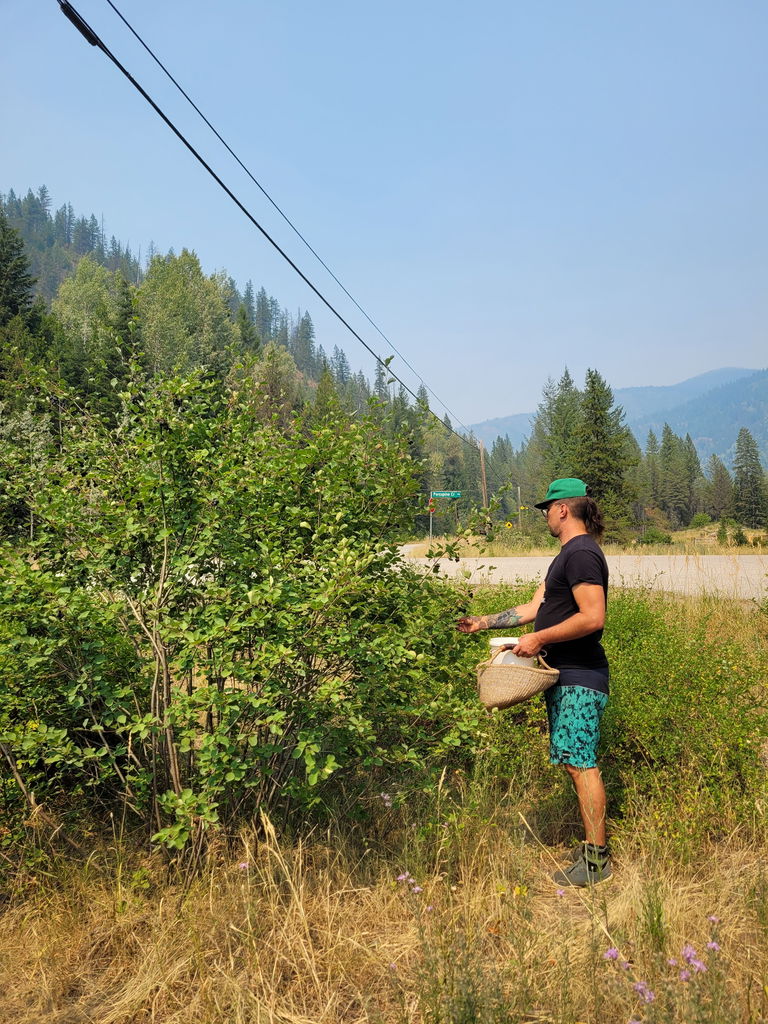
On Damian’s property, there are tons of Saskatoon berries and hawthorn berries. We collected those. Then, when we got to the retreat, we foraged around the area. The original plan was to go to the other side of Kootenay Lake and hike, but with the forest fires, we just couldn’t. I was able to use foraged material that I’ve never worked with. I was learning at the same time as Damian and he got to see my spontaneous process. I think that’s the best way to learn.
I’m going to leave some equipment with him, so he can continue to make paper and make prints on his own time.
Silkscreen printmaking is the chosen technique for our collaboration. I was able to set up a pretty janky mobile station, and it worked fine.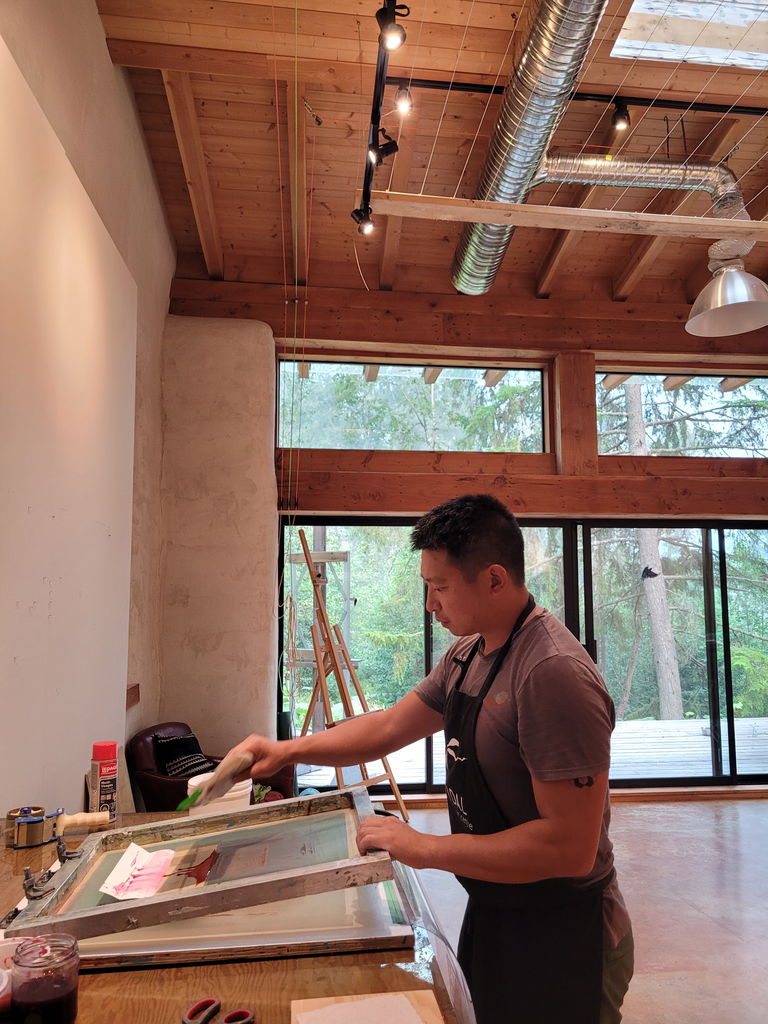
Once Damian got the basics down, I took some time to myself to draw my visual concept. He printed so much in the last two days. It was crazy! He worked all day until night. It was great to see what he was doing and to feed the collaborative spirit.
Hopefully this leads to other opportunities for both of us, especially for Damian. There are many other printmaking residencies out there and other techniques to explore. 
During the residency, we shared a lot of stories with each other.
The Narrows Art Retreat was a short residency. It was intense at times, but we took breaks, and we gave each other a lot of privacy and space. We talked a lot and got to know each other, our values, and each other’s stories—things about family members and about how we grew up and came to be who we are today. Damian has really opened up to me, and I appreciate that. It’s been really inspiring.
Mallory: Can you speak more about the concept of making your own versions of paper money?
Ed: I’m still in the process of figuring the project out. It was great to speak with Damian about it because this project is something that he was already working on—a decolonization project on money. I’ve been thinking about it since he approached me. Discussing the concept with him has been very thoughtful.
Money has traditional ties to a mix of Daoist, Bhuddist, and indigenous cultural practices in Taiwan. My parents are religiously Protestant, so growing up, we didn’t perform traditional Taiwanese rituals, but my grandparents and other family members did. There were these cultural practices that I never experienced as a child and felt excluded from the greater population.
There’s so much about printmaking and papermaking in those practices. I’ve been asking myself, “how do I, as an adult, artist, and Canadian, interpret these practices?”
I think Damian can speak more about how the concept of “money” has evolved for him.
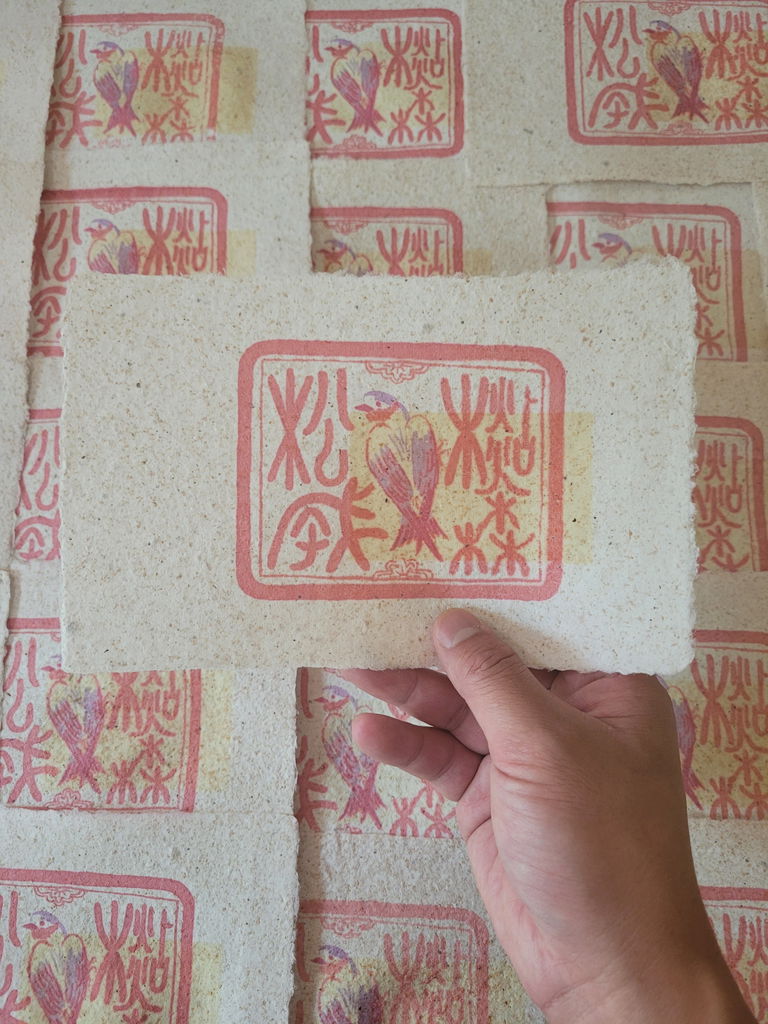
Damian: The real curious thing for me that has shown up during this residency is this exploration of money and paper. I’m always angling my creative brain to think about things like, as people, how do we relate? How do we interact? How do we share stories with one another? What’s important?
My thoughts on the project were focusing on Canadian money to some degree and then Ed was exploring some of his own histories. We started talking about what he called charms or Spirit Money. In Taiwan, they burn stacks of money that aren’t real. It’s a practice of honouring their dead people. I thought that was really interesting because the fake money, I don’t even know if you can call it fake money…The spiritual money is some kind of currency for honouring their people. This idea broadens the concept of what is valuable, what is important in life, and about how we relate.
This aspect, for me, has really taken the project away from this idea of hating money and capitalism—figuring out how to speak to that—and turned it more into a way to think about all of the inputs that we have individually that make us consider what we value and how we value it.
In the time we’ve spent together, there’s been this coupling of ideas. He was making these beautiful charms, and I thought, “well, I’m going to do my own version and interpretation of that, just to see what happens.” Now, Ed and I are in this relational space because we’re spending lots of time together and speaking about things that influence how we see things that are valuable. It’s an evolving process.
I like to think about not just what the art is doing or showing but also the meta component of it. What are we speaking to more broadly? For me, how do I create a better, more beautiful world as a person and as an artist? This project is really starting to speak to those things for me, because here we are…we don’t really know each other. We committed to spending a week basically living together in this tight environment. We really don’t know if our residency is going to be successful or not, because we haven’t spent any time previously with each other. It could have been a catastrophe. It wasn’t.
Because of our close interaction we began to create something that speaks to cultures coming together. We’re both Canadian identified and intertwined in the bigger scheme of this country, but we have very different ethnic inputs. Yet, there are some similarities with those inputs too. They look slightly different, but there are some crossovers. There’s this sort of sharing that is happening between us.
One of the reasons I like doing art is because it goes places that you can’t really foresee, but that often makes it better.

Mallory: It seems as though you two were really open to learning from one another. What do you think?
Damian: Yeah, for sure. Ed has been printmaking for almost two decades. He has a deep interest in papermaking and inkmaking, and that’s beautiful to me. The fact that he would want to share it, that’s also beautiful. It feels good to be able to come together and share things and learn.
Ed: I also want to give credit to Damian for approaching me. He’s the one who really encouraged us to grow as an equal partnership. He lended me the space to figure it out as well and also express my critical thinking on this topic.
Damian didn’t just ask me to assist him during this residency. He invited me to be a partner in his project, which I find to be a huge honour.
Overall, I wish our residency was longer.
Mallory: Can you describe your collaborative material process? How do you make the paper, ink, and prints?
Ed: Fundamentally papermaking is basically just breaking down fibres to make pulp. It’s almost like textile weaving, but you’re breaking a material down by blending it into mush. Using specific tools, you reconnect the fibre into a piece of paper. So, it’s almost like you’re weaving a microscopic cellulose material. We played with not just cedar and hemlock but also cottonwood fibre that was flying around the residency property. It turned out to be a beautiful material. It’s so similar to cotton. I couldn’t tell the difference, except when we were cleaning it. It was a painstaking process. But, Damian encouraged me to leave some of the debris in the pulp because that is also part of the forging process—that is part of the paper’s story.

In terms of the ink extraction, I always focus on and highlight endemic and native plants from the region where I’m working. You can make ink from anything: carrots, beets, and cabbage.
I want to find a path that leads to ecological conservation. It’s another way of looking at nature wherever you reside. The wilderness is not solely for visual admiration of a mountain or forest scene. I find my own connectivity to nature through my techniques.
Damian and I discussed the endeavour of creating our own art supply for printmaking and papermaking. We feel more strongly connected to the finished pieces through the process.
During the residency, I was able to demonstrate to Damian the fundamental techniques of silkscreen printmaking, ink making, and papermaking. For an entire day he was making ink from our foraged ingredients. The same day, I was making paper. The next day we shared our materials together to create our individual “paper money” pieces. It was a nice experience for me because he dived deeply into the process without hesitation.
Damian: As far as the work goes, it has stretched more. Initially, I was looking at money as a construct. By deconstructing it and working with somebody else to do so, I’ve begun to see the project as a very complex set of relationships.
In Tl’azt’en culture, and in a lot of cultures, story is one of the most important things. Stories get passed on. They hold information from thousands of years ago. Images like pictographs are simple. An image might look like a stick figure of a caribou, but when you talk to other Indigenous peoples from around the world, you learn that very simple images often hold huge amounts of information. It’s as if the Bible were condensed into a single “C” shape. The Indigenous knowledge keepers were the ones who held onto that information and used more simple visuals as a way to hold information. These images stretch backwards, kind of invisibly, or into space that we don’t see very well.
That’s what this money project is doing for me. It’s allowing me to see where each piece stretches backwards into a story, and how stories can be shorter and condensed through visuals.
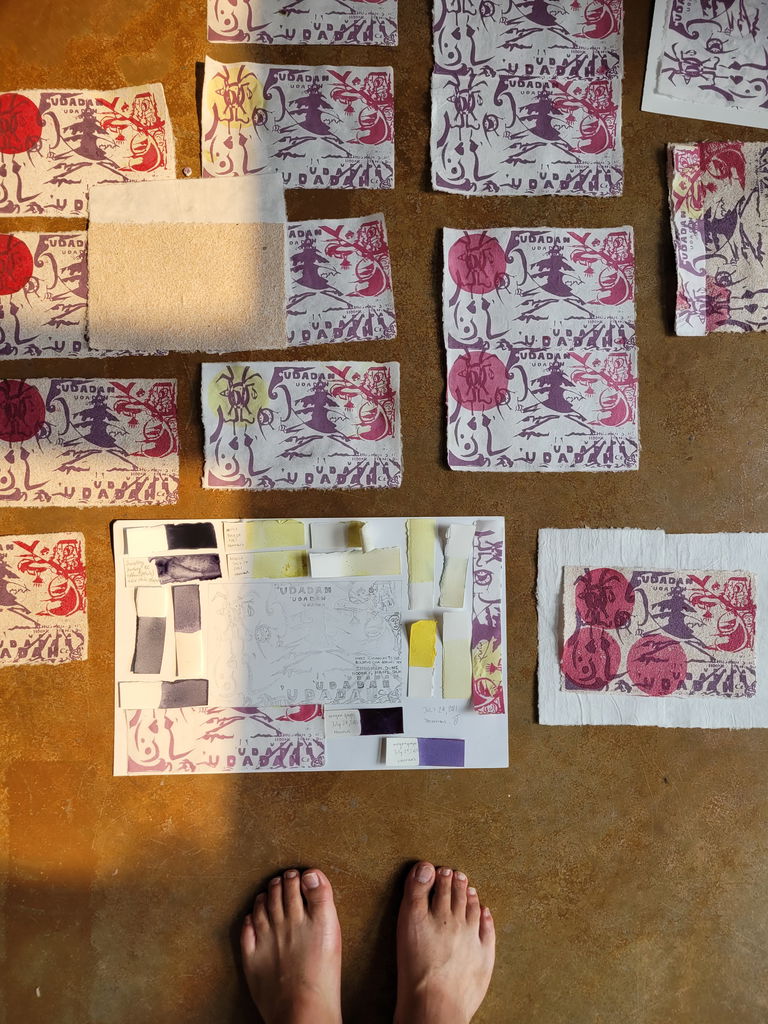
Joanne and Mark are my neighbours who have been supportive, lovely people, and I’ve known them for a while now. They’ve always been generous with their resources. Their generosity in letting us use shavings from their lumber yard has become part of the story for me and part of the art. They could’ve easily said no to us or asked us to pay $60 for this or that. Maybe, I would’ve had to sneak in to gather resources. If so, the work would become an entirely different story. That aspect is very interesting to me. I’m still trying to figure out how to reflect that in the visual art pieces. I’ve been thinking about how to pass this piece of information on in the work. Should it stay hidden? And if I pass this information on, does the artwork become more valuable or less valuable to people?
I’m learning that this project has a deep well for possibility.
Mallory: What are you hoping to work on together in the future? Do you have plans for the work that you’ve created?
Ed: Damian grew up in the northern region of BC. We discussed someday visiting his native home together and hosting workshops to forage with the community there.
I have an upcoming show at the Port Moody Art Gallery from February 24 to March 22, 2022.
I’m working on an exhibition in Taipei, at the Suho Memorial Paper Museum for January-May 2023. Maybe Damian can be a part of it, or I can bring back plants from Taiwan to work with.
We haven’t really spoken about concrete plans yet. Obviously, we want to show what we’re working on. It’s very fresh, so it will take time. However, it is a seed that’s planted. The goal is to exhibit and showcase this work in progress and to continue practicing collaboration. Where, when, or how? We don’t know.
Damian: I’ve got a couple shows coming up in the fall. One is at Artful: The Gallery in Courtenay, BC and one will be at the Langham Cultural Centre in Kaslo, BC from October to December, 2021. Both exhibits will show the comic series I created last year. Some of the work I’ve been creating on this collaborative topic may show up in the exhibit at the Langham.
There’s definitely the possibility that we can pull this work together in a bigger way. One of the things that I’m really curious about is to ask other creative individuals to think about the idea of value and currency and to meld it into their art. Perhaps even, to ask artists to reflect on their indigenousity, because we all have indigenous roots in some form or another. It could be interesting to have a number of individuals create pieces of art in a similar way that we’ve been doing. It’s interesting because art is a form of currency itself. It’s a currency that human beings have valued for thousands of years. How does a hundred dollar bill relate to a Van Gogh or Ed’s beautiful plant artworks? Maybe if I knew the story of the $20 Canadian bill, I might have a better relationship to it. Imagine having 30 artists all pulling these ideas and their stories together. Maybe if we did a better job of seeing each other, we’d have less harm in the world. We’d be more custodial. I’m always trying to push advocacy into the creative space. Working with more artists on this topic could be a cool thing to explore.
If Ed and I had a whole month together, we’d have enough work to fill a room. It takes time to create. But, our collaboration was definitely cultivated because of BC Culture Days. I never would have met Ed without the ambassadorship.
Mallory: Do you have any advice or words of encouragement you’d like to pass on to current and future BC Culture Days Ambassadors?
Damian: Building relationships is most important. I still have a relationship with my mentor, Sonny Assu. That has been really, really valuable.
Take some time to connect with at least one person. It’s hard to connect with everybody in an intimate kind of way, but both Ed and I had to want to connect to each other. I would recommend people do that. Make a creative friend and see what comes out of it. I find that ideas start to show up in a more nuanced and provocative way than when I think about things by myself.
Ed: When we were chosen as ambassadors, it was at the height of the pandemic. Most of us had to do the workshops online. I had one or two in-person, but not many people came. However, the BC Culture Days experience was great. I got to meet Damian. I was able to pay my mentor to teach me the technical aspects of paper-making. Even though I already knew the basics of papermaking, it helped me move forward with my practice.
My advice is to plan your events as big as possible. That way, no matter where you’re at, you can always go with the flow and pull back if you need to. You can’t control the pandemic, but you can control your creativity and adaptation to change.
Damian actually requested the idea of doing an ambassador group check in every few weeks. Us ambassadors met on zoom more than once. We talked about each other’s projects and the challenges we encountered. I got to know what everyone was doing, and it motivated me to keep going. This is how Damian approached me—it was a result of these check-ins and conversations.
It’s a really great program, especially for emerging artists.
Mallory: How can people follow along with your journey and learn about upcoming exhibitions or events?
Ed: I’m pretty active on my Instagram. Whenever we make progress with the project, I’ll post about it there.
Damian is less addicted to social media. You can follow his website. An interesting story: I posted some progress shots of our work on social media. I had a bunch of people direct message me to ask to buy our Spirit Money prints. Little do they know that my intention is to burn them, because that’s the traditional practice.
It’s funny, because when I posted the work, other people responded to the same post and messaged me asking how I was going to burn the money. When are you going to burn them? Are you going to videotape when you burnt it? Are you going to burn half of it? How are you going to show it?
Mallory: That’s fascinating! So, by sharing your process on social media, it gives your project an extra conceptual layer that relates back to ideas of personal and cultural knowledge? It showcases how different cultures view the concept of money, and how they respond to what is valuable. It also relates back to how art is a form of currency because some people are already asking to pay you for your artwork.
Ed: It’s interesting to think about. I got a kick out of it. It’s only been a few days and that was already the reaction.
Thank you to our lovely past ambassadors for this rich conversation about the importance of collaboration. Their project showcases how collaboration encourages learning, exploration, and meaningful creativity. To follow along with their practices visit their personal media links listed below.
Ed Fu-Chen Juan:
Website: www.edjuan.com
Instagram: @edjuandraws
Damian John:
Website: www.caribouwoman.com


